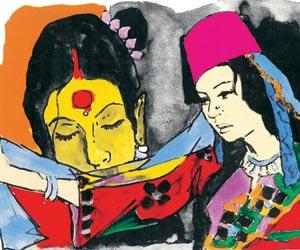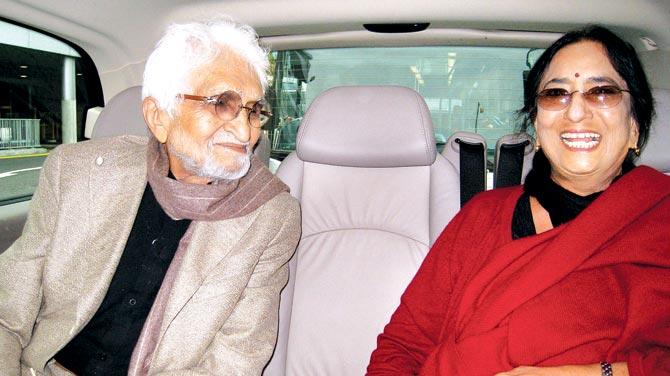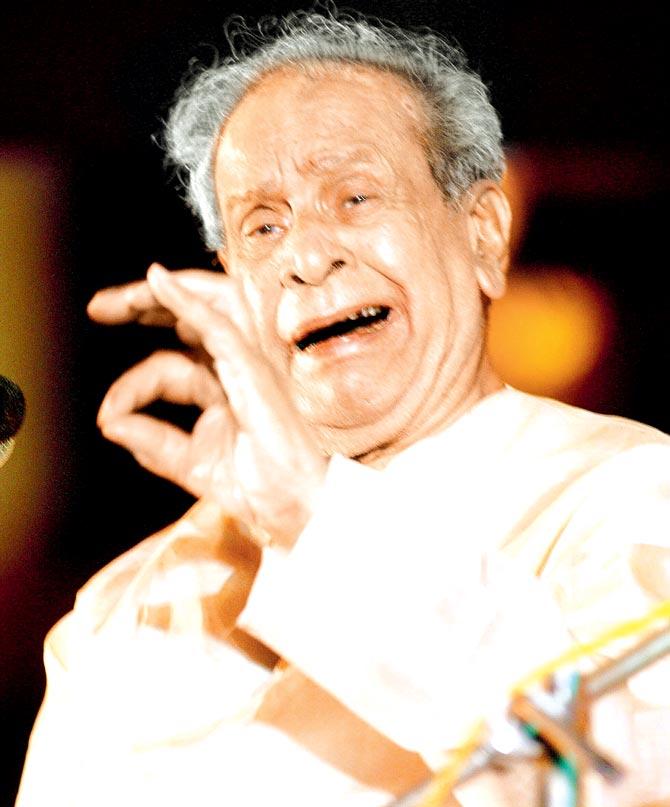Artist Ila Pal recounts the time when Modernist painter MF Husain 'live-painted' the legendary vocalist Pandit Bhimsen Joshi as he sang - a jugalbandi that was dismissed by critics as a gimmick

27 January 1988
I discovered only today, when [MF] Husain came, that what had upset him yesterday were the comments of two of his painter friends. They had dismissed his attempt to interpret Bhimsen Joshi's music through painting. Immediately after the performance, I had gone up to the stage but had fled when I saw Husain looking so irritable. 'It was no stunt,' was Husain's opening sentence as he walked in conveying his chagrin and his desire to clarify.

Husain was deeply fascinated by cinema and music. He made small paintings, which when fed in a kaleidoscope, narrated a story
'I was putting forward a pictorial proposition or theorem which had to be resolved on the canvas. I wanted to structure pure sound, using colours for their own energy. At the same time, I wanted to transmute the abstraction inherent in Indian classical music through colour association … Painters would be the first to realize this, I thought, but they didn't. That's what has bothered me.
'As far as others are concerned, I could have pleased them so easily. Give me a canvas twice as large as the one I painted yesterday, in ten minutes I can paint a complete picture. Why one, there are ten different ways I could have painted the same subject, but that was not what I wanted to do. Had I chosen a familiar image and even given it a new twist, it would have met with the expectations of most,' Husain saheb said.

MF Husain and Ila Pal in London, 2008
'But you chose to do it this way. Why?' 'To share with the viewers the adventure and the search that is painting.' What was interesting was that it became an event because it was Husain. And because it was Husain, the audience couldn't separate the person from the process, that is, the painting. If VS Gaitonde, Husain's favourite painter and colleague, had done the painting, he might have been more successful. Gaitonde was a profound listener, and abstraction was inherent in his painting as it is in Indian classical music, but neither Gaitonde nor any other significant contemporary painter would have undertaken to paint in public, for the public.
That Husain was made differently is beyond dispute. Imagine the adolescent Husain slinking out of the house, cycling down to the city morgue, sneaking in through a window left open every night through 'oversight', to study the human anatomy. In later years too he tested his courage by going to cemeteries and spending several hours there every night.

The late Hindustani classical vocalist, Pandit Bhimsen Joshi
In the course of going through a life of hardship, Husain developed not only a strong nerve but the capacity to work under trying conditions. For years he spent the day working as a furniture designer and the night on the attic of his one-room tenement, half-bent, painting. Having conquered the fear of the dead, the fear of being watched, of making 'mistakes' in public, Husain had developed a grit that few possess. Having learnt to handle a variety of materials and tools, he had acquired perfect motor control matched only by his physical stamina; and in isolating himself from the surroundings, Husain perfected the art of aloneness.
When Husain 'painted the music' at the Tata Theatre in Bombay, he was no less alone. That's why he could dare to paint music. The music of Pandit Bhimsen Joshi, before a formidable gathering of painters – critics, art dealers, collectors, and the elite whose feelings were a mix of curiosity and confrontation. There was contradiction in the situation. People expected Husain to react to the music, not churn out the familiar. At the same time, they expected to see images they associated with Husain.
When Husain reacted, he did so to the absoluteness of music, its abstractness. He used colours to convey the density of Bhimsen Joshi's notes, the purity of their brilliance. It was inconsequential whether the painting was a masterpiece or just mediocre. What was important was the validity of the method Husain followed, and the attitude he adopted – but few bothered to examine this.
It was in 1968 that he first invited people to watch him paint in Delhi. Looking back on that event, Husain saheb said: 'Although the critics in Delhi brushed it aside as a stunt, my painting several canvases in full view of the public caused a lot of interest. People came to see a painter paint, some from far-off towns. I spread out six canvases on the floor and painted them almost simultaneously - one serene, another stark, the third simple, and so on. I worked for five days, for two to three hours every day. Not all the paintings were successful. I was willing to let people see my failure as well. Two of the paintings were unsatisfactory, but I cannot trace the cause.
No, it was not inspiration… perhaps, not even mood. The exact moment when a creative energy gets transformed into the stroke of a pen or a brush determines its authenticity, its force. And this creative energy is a result of years of concentrated practice. I like the word riyaaz used commonly in classical music. A musician practises each note to perfection… until it acquires the required depth and density. One single note of such a musician can transform the atmosphere. It can strike your being like an arrow. Bhimsenji proved what I mean by this.'
Excerpted with permission from Husain: Portrait of an Artist (2017) by Ila Pal published by HarperCollins Publishers
 Subscribe today by clicking the link and stay updated with the latest news!" Click here!
Subscribe today by clicking the link and stay updated with the latest news!" Click here!









